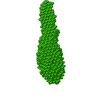+Search query
-Structure paper
| Title | Identification of two p23 co-chaperone isoforms in Leishmania braziliensis exhibiting similar structures and Hsp90 interaction properties despite divergent stabilities. |
|---|---|
| Journal, issue, pages | FEBS J, Vol. 282, Issue 2, Page 388-406, Year 2015 |
| Publish date | Nov 21, 2014 |
 Authors Authors | Fernanda A H Batista / Glessler S Almeida / Thiago V Seraphim / Kelly P Silva / Silvane M F Murta / Leandro R S Barbosa / Júlio C Borges /  |
| PubMed Abstract | The small acidic protein called p23 acts as a co-chaperone for heat-shock protein of 90 kDa (Hsp90) during its ATPase cycle. p23 proteins inhibit Hsp90 ATPase activity and show intrinsic chaperone ...The small acidic protein called p23 acts as a co-chaperone for heat-shock protein of 90 kDa (Hsp90) during its ATPase cycle. p23 proteins inhibit Hsp90 ATPase activity and show intrinsic chaperone activity. A search for p23 in protozoa, especially trypanosomatids, led us to identify two putative proteins in the Leishmania braziliensis genome that share approximately 30% identity with each other and with the human p23. To understand the presence of two p23 isoforms in trypanosomatids, we obtained the recombinant p23 proteins of L. braziliensis (named Lbp23A and Lbp23B) and performed structural and functional studies. The recombinant proteins share similar solution structures; however, temperature- and chemical-induced unfolding experiments showed that Lbp23A is more stable than Lbp23B, suggesting that they may have different functions. Lbp23B prevented the temperature-induced aggregation of malic dehydrogenase more efficiently than did Lbp23A, whereas the two proteins had equivalent efficiencies with respect to preventing the temperature-induced aggregation of luciferase. Both proteins interacted with L. braziliensis Hsp90 (LbHsp90) and inhibited its ATPase activity, although their efficiencies differed. In vivo identification studies suggested that both proteins are present in L. braziliensis cells grown under different conditions, although Lbp23B may undergo post-translation modifications. Interaction studies indicated that both Lbp23 proteins interact with LbHsp90. Taken together, our data suggest that the two protozoa p23 isoforms act similarly when regulating Hsp90 function. However, they also have some differences, indicating that the L. braziliensis Hsp90 machine has features providing an opportunity for novel forms of selective inhibition of protozoan Hsp90. |
 External links External links |  FEBS J / FEBS J /  PubMed:25369258 PubMed:25369258 |
| Methods | SAS (X-ray synchrotron) |
| Structure data |  SASDC85:  SASDCV5: |
| Source |
|
 Movie
Movie Controller
Controller Structure viewers
Structure viewers About Yorodumi Papers
About Yorodumi Papers



 Leishmania braziliensis (eukaryote)
Leishmania braziliensis (eukaryote)